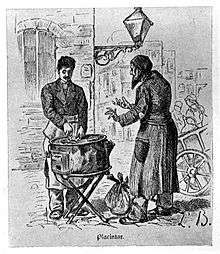Placenta cake
| Type | Pie |
|---|---|
| Place of origin | Roman empire |
| Main ingredients | Flour and semolina dough, cheese, honey, bay leaves |
|
| |

Placenta is a dish from ancient Rome consisting of many dough layers interspersed with a mixture of cheese and honey and flavored with bay leaves, then baked and covered in honey.[1][2] Cato included a recipe in his De Agri Cultura.[3] Cato writes:
Shape the placenta as follows: place a single row of tracta along the whole length of the base dough. This is then covered with the mixture [cheese and honey] from the mortar. Place another row of tracta on top and go on doing so until all the cheese and honey have been used up. Finish with a layer of tracta.[2]
It derives from the Greek term plakous (Greek: "πλακοῦς", gen. "πλακοῦντος" – plakountos) for thin or layered flat breads,[4][5][6] and several scholars suggest that its Eastern Roman (Byzantine) descendants, koptoplakous (Byzantine Greek: κοπτοπλακοῦς) and plakountas tetyromenous, are the ancestors of modern baklava and tiropita (börek) respectively.[7][2][8] The name placenta (Greek: "πλατσέντα") is used today on the island of Lesbos in Greece to describe a baklava-type dessert of layered pastry leaves containing crushed nuts that is baked and then covered in honey.[9][10][11] Another variant of the Roman dish survived into the modern era as the Romanian plăcintă cake.
Through its Greek name plakountos it was adopted into medieval Armenian cuisine as plagindi, plagunda, and pghagund, all "cakes of bread and honey."[12] From the latter term comes the Arabic name iflaghun, which is mentioned in the medieval Arab cookbook Wusla ila al-habib as a speciality of the Cilician Armenians settled in southern Asia Minor and settled in the neighboring Crusader kingdoms of northern Syria.[12]
References
- ↑ "American Pie". American Heritage. April–May 2006. Retrieved 2009-07-04.
The Romans refined the recipe, developing a delicacy known as placenta, a sheet of fine flour topped with cheese and honey and flavored with bay leaves.
- 1 2 3 Faas, Patrick (2005). Around the Roman Table. University of Chicago Press. p. 184-185. ISBN 0226233472.
- ↑ Cato the Elder. "De Agricultura".
- ↑ placenta, Charlton T. Lewis, Charles Short, A Latin Dictionary, on Perseus
- ↑ πλακοῦς, Henry George Liddell, Robert Scott, A Greek-English Lexicon, on Perseus project
- ↑ placenta, Concise Oxford English Dictionary Luxury Edition, Oxford University Press, 2011, p.
- ↑ Rena Salaman, "Food in Motion the Migration of Foodstuffs and Cookery Techniques" from the Oxford Symposium on Food Cookery, Vol. 2, p. 184
- ↑ Speros Vryonis The Decline of Medieval Hellenism in Asia Minor, 1971, p. 482
- ↑ ΠΟΛΙΤΙΣΤΙΚΟ ΙΔΡΥΜΑ ΟΜΙΛΟΥ ΠΕΙΡΑΙΩΣ, ΜΑΓΕΙΡΕΥΟΝΤΑΣ ΜΕ ΛΑΔΙ ΚΑΙ ΑΛΛΑ ΣΤΗΝ ΑΓΙΑ ΠΑΡΑΣΚΕΥΗ ΛΕΣΒΟΥ
- ↑ http://www.bostanistas.gr/?i=bostanistas.el.article&id=3528
- ↑ Λούβαρη-Γιαννέτσου, Βασιλεία (2014). Τα Σαρακοστιανά 50 συνταγές για τη Σαρακοστή και τις γιορτές (Lent foods: 50 recipes for Lent and the holidays).
Η πλατσέντα είναι σαν τον πλακούντα των αρχαίων Ελλήνων
- 1 2 Perry, Charles. "Studies in Arabic Manuscripts," in Rodinson, Maxime, and Arthur John Arberry. "Medieval Arab Cookery." (2001). p. 143